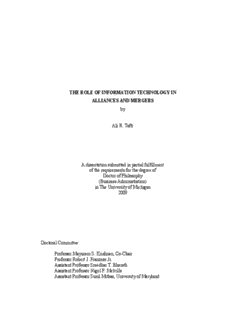
THE ROLE OF INFORMATION TECHNOLOGY IN ALLIANCES AND MERGERS PDF
Preview THE ROLE OF INFORMATION TECHNOLOGY IN ALLIANCES AND MERGERS
THE ROLE OF INFORMATION TECHNOLOGY IN ALLIANCES AND MERGERS by Ali R. Tafti A dissertation submitted in partial fulfillment of the requirements for the degree of Doctor of Philosophy (Business Administration) in The University of Michigan 2009 Doctoral Committee: Professor Mayuram S. Krishnan, Co-Chair Professor Robert J. Franzese Jr. Assistant Professor Sreedhar T. Bharath Assistant Professor Nigel P. Melville Assistant Professor Sunil Mithas, University of Maryland © Ali R. Tafti 2009 DEDICATION I dedicate this work to my parents, Mohammed and Shahnaz Tafti, who are my greatest role models and two of my best friends; and also to my beloved wife Marmar, who inspires me to persist and brings me great happiness. i i ACKNOWLEDGMENTS I am grateful to members of my dissertation committee, and would like to acknowledge them individually, although in no particular order. I would like to thank my advisor and committee chair, Professor M.S. Krishnan, who recognized my potential and encouraged me. This work would not have been possible without his generous support, mentorship, and willingness to listen and help shape my ideas. Sunil Mithas has been an excellent collaborator on many research projects with me, as well as a kind and generous mentor through the years. Sunil has carefully reviewed and made valuable suggestions in writing and analysis in many versions of the chapter entitled Information Technology, Service-Oriented Architectures, and the Firm-Value Effects of Alliance Formation. Sreedhar Bharath has provided many valuable suggestions and mentorship on the chapter entitled The Effects of Information Technology Investment and Integration Costs on Merger Value in the U.S. Commercial Banking Industry. Sreedhar has also helped me improve my skills in econometric analysis. Nigel Melville has also been a mentor to me, in many informal and formal meetings; he has read and provided valuable feedback on a broad range of my writings; and he has greatly enriched the PhD experience for my colleagues and me through his active presence in the department. Finally, I am deeply grateful to Robert Franzese who, besides being an excellent teacher of econometrics, has met with me regularly since the spring of 2008 to review the progress of my work and iii provide valuable feedback in each step of the way. I would also like to extend my thanks for many valuable comments provided on the empirical study on SOA, IT, and alliances by three anonymous journal reviewers, participants at ICIS in Paris in 2008, INFORMS annual meeting in Seattle in 2007, Big 10 Information Systems Research Symposium at Purdue University, the University of Michigan Business Information Technology Department seminar series, the Internal Entrepreneurship Workshop, and the bi-annual STIET Research Workshop at the University of Michigan for their valuable comments. Financial support was provided in part by NSF IGERT grant no. 0114368. I would also like to extend my thanks for many valuable comments provided on the empirical study on IT and bank mergers by seminar participants at CIST in Seattle in 2007, and WISE in Paris in 2008. I thank Ben Fields, Chandra Pathuri, Sophia Zhuo, Cory Simonds, and Robyn S. Wang for their assistance in data collection. iv TABLE OF CONTENTS DEDICATION ii ACKNOWLEDGMENTS iii LIST OF TABLES viii LIST OF FIGURES x ABSTRACT xi GENERAL INTRODUCTION 1 CHAPTER I. Towards a Theoretical Framework of Information Technology in Alliances and Mergers 3 I.1. Inter-Organizational Relationships and Governance Requirements I.2 Contracting Hazards in the Role of IT in Inter-organizational Relationships I.3 Coordination and Reconfiguration in Inter-organizational Relationships I.4. A Dynamic Capabilities Perspective of IT-enabled Reconfiguration in Inter- organizational Relationships References II. Propositions on the Value of Flexible IT Systems in Strategic Alliances 19 II.1. Contracting Perspective v II.2 Coordination Perspective II.3. Dynamic Capabilities Perspective II.4. Conclusion: IT, Business Process Flexibility, and Strategic Flexibility References III. Information Technology, Service-Oriented Architectures, and the Firm-Value Effects of Alliance Formation 46 III.1 Introduction III.2 Theoretical Framework III.3. Research Design and Methodology III.4. Discussion Appendix 1: More Variable Definitions Appendix 2: Derivation of Baseline Tobin’s Q Model Appendix 3: Coding and Verification of Alliance Attributes Appendix 4: Unabridged Regression Tables References IV. The Effects of Information Technology Investment and Integration Costs on Merger Value in the U.S. Commercial Banking Industry 104 IV.1. Introduction IV.2. Background Literature IV.3. Theory and Hypotheses IV.4. Methods IV.5. Results IV.6. Discussion References v i V. Final Considerations 165 vi i LIST OF TABLES TABLE II.1 Overview of Propositions and Key Constructs 40 III.1 Correlations and Summary Statistics 80 III.2 Baseline Value of IT Specifications 81 III.3 IT Interactions with JV and Non-Equity Alliances 82 III.4 SOA Interactions with JV and Non-Equity Alliances 83 III.5 SOA Interactions with Collaborative and Arms-length Alliances 84 III.6 Features of Collaborative Alliances 85 III.7 Examples of Collaborative and Arms-length Alliances 86 III.A1 Strong and Weak Keywords for Collaborative and Arms-length Alliance 91 Deal-text Content Analysis III.A2 Cross-sectional Proportions of Alliance Formation Characteristics 91 III.A3 Baseline Value of IT Specifications, Unabridged Results 93 III.A4 IT Interactions with JV and Non-Equity Alliances, Unabridged Results 94 III.A5 SOA Interactions with JV and Non-Equity Alliances, Unabridged Results 96 III.A6 SOA Interactions with Collaborative and Arms-length Alliances, 97 Unabridged Results IV.1 Variable Definition and Data Sources 140 viii IV.2 Summary Statistics 142 IV.3. Pairwise Correlations Matrix 143 IV.4 OLS Regression Results including Control Variables: Cost Efficiency 144 IV.5 Abridged IVREG Results 146 IV.6 Abridged OLS Results for ROA and Deposits-To-Assets 147 IV.7 Abridged Cumulative Abnormal Returns (CAR) 148 IV.8 Cumulative Abnormal Returns, Comparison of IVREG Results with 149 Integration Costs and OLS Results with Proxy for Integration Difficulty IV.9 Unabridged OLS Results for Profitability (ROA) 150 IV.10 Unabridged OLS Results for Customer Retention (DOA) 152 IV.11 Unabridged IVREG Results for Cost-efficiency, Including First-stage 154 Regressions IV.12 Unabridged IVREG Results for Profitability, Including First-stage 156 Regressions IV.13 Unabridged IVREG Results for Customer Retention, Including First-stage 158 Regressions IV.14 Unabridged IVREG Results for CAR1 160 ix
Description: